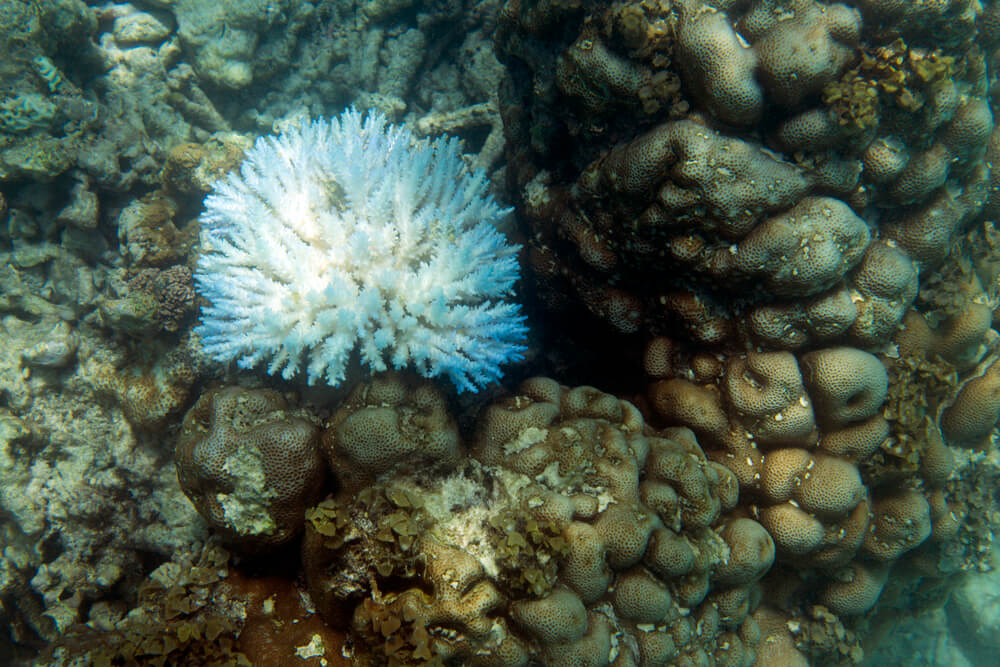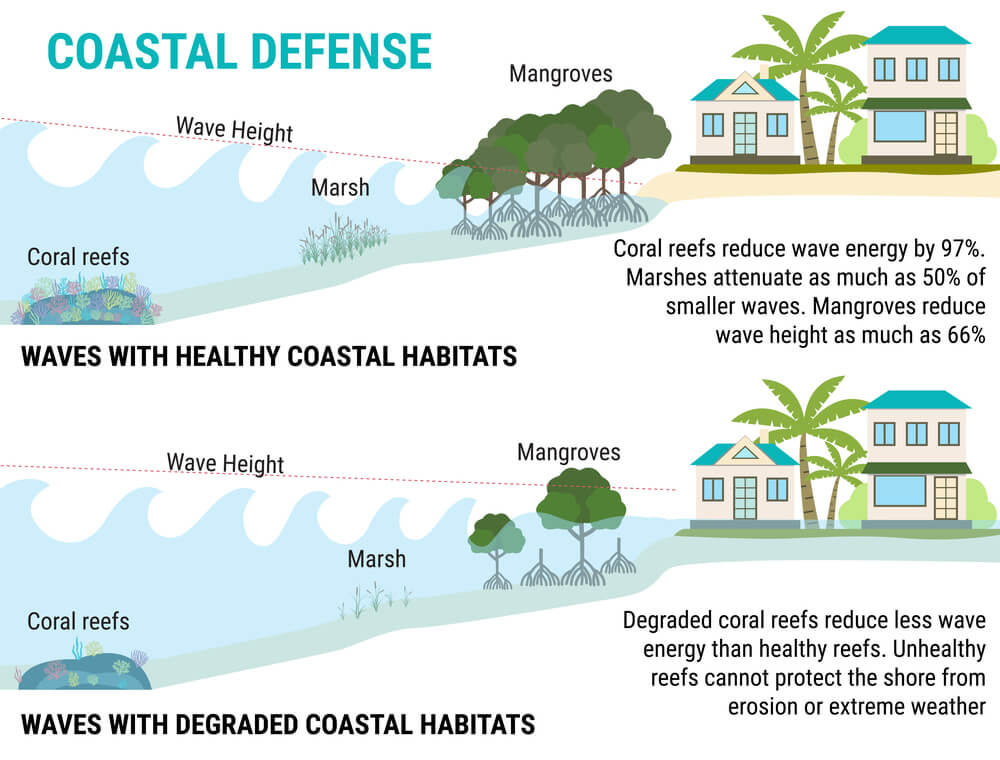Coral reefs, also called the rainforests of the sea, are unique underwater treasures. Occupying less than 1 percent of oceans, they are still home to 25% of known marine species. Unfortunately, rising sea temperatures due to climate change in the past decades have led to increased coral bleaching, resulting in a decline in growth in coral colonies.
Coral reefs and mangrove forests are the most endangered habitats in today’s world. A recent study by NTU Singapore and Macquarie University in Australia found that continuously rising sea temperatures will devastate coastal habitats within the next 30 years. The study shows that if global warming exceeds 2 degrees centigrade, the coral reefs will not survive.
The Critical Role of Coral Reefs and Mangroves
Coral reefs are among the most diverse ecosystems in the world. With an economic value of $375 billion annually, they provide food to millions of people in over 100 countries and territories. They also provide habitat and shelter to many marine species and provide nursery grounds for juvenile fish populations to breed without worrying about predators. Serving the role of the first line of defense, they protect coastal communities from incoming large waves and rising sea disasters.
The primary advantage of coral reefs is that they protect against storms. Coral reefs act as natural barriers, with their shape protecting the shoreline from waves and storms.
The Grim Forecast: Global Warming and Rising Sea Levels
Since the days of the Industrial Revolution, carbon dioxide emissions have increased exponentially. This increased rate of emissions and the release of GHGs continues to make the effect of global warming worse. Almost 1/4th of these emitted gases are absorbed by ocean water.
When we look closely at the study by NTU Singapore, the statistics show that if global warming is limited to 2 degrees centigrade, around 95% of the coral islands would survive. The study further says that if the temperature continues to rise and reaches up to 3 degrees centigrade, the sea level will rise nearly by 7mm a year, which will make it more difficult for the coral reef islands to survive.
The updated data shows that in January 2023, the sea level was 89.9 millimeters higher than in the same month in 1993. The data further indicates that the rise in sea level is accelerating and has hauled from 0.06 inches per year to 0.14 inches per year in the last decades.
The Tipping Point: When Adaptation Fails
A threshold is a limit by which mangroves and corals work efficiently. As the sea level rises, the mangroves face increased inundation that hinders their working, and mangroves may struggle to trap sediments effectively. This situation can compromise their role in stabilizing coastlines and filtration.
Likewise, the efficiency of coral reefs is sensitive to the increase in temperature. Corals expel their symbiotic algae when the temperature exceeds the threshold for extended periods, which can lead to color bleaching. The prolonged coral bleaching events can lead to the death of coral colonies and a decline in reef health.

The Paris Climate Agreement and Its Goals
The United Nations Paris Agreement 2015 comprises a comprehensive set of objectives focusing on limiting global warming below 2 degrees Celsius and efforts to limit the increase to 1.5 degrees Celcius. The summit put many goals forward with the promise to eradicate this global problem that is the primary cause of death of coral reefs.
Participating countries submit nationally determined contributions outlining their commitment to reducing greenhouse gas emissions. All the participants mutually agreed and joined hands to promote the advancements, enhancing sustainability and reducing the emission of greenhouse gasses.
Adhering to the objectives of the Paris Climate Agreement, which includes many joint ventures such as global temperature limits, mitigation commitments, and other goals, can reduce global warming while reducing the risk of rising sea levels. These measures will also help us retain our environment for ourselves and future generations.
Cultural and Economic Significance of Coral Islands
Coral reefs, along with being important to marine life, are also significant for the people living near them. The Caribbean region almost consists of 9 to 10% of the world’s coral reefs. Coral reefs are both cultural and economic here because, as per an estimate, around 41 million people are likely dependent upon the reefs for their food or livelihood, and about 100 million people benefit from coral reefs through food or medication. The coral reefs are also beneficial for tourism, as many people worldwide visit these places, eventually causing the tourism industry to flourish.
Apart from the financial gains, these reefs also have significant cultural importance. Coral islands often serve as the ancestral homes of indigenous communities. These islands are deeply tied to the cultural identity and history of the people living there. Many traditional and religious practices of those living here revolve around these coral reefs. The rich biodiversity and the vibrant marine life are the axis of art and culture here. Fishing is the primary occupation of the natives as it also serves as food for them, and they can trade fish to earn money.
The Future of Coastal Habitats and Human Settlements
We need to understand how we are contributing to the destruction of the environment. Rising sea levels are a primary concern not just for those living near the coastal areas but for the global community. The continuous rise in the sea level also increases the vulnerability of infrastructure such as coastal ports, roads, and buildings. The debate does not end here; rising sea levels can have severe economic consequences, affecting many industries, such as tourism and fishery, that are closely tied to the coastal areas.
Paradoxically, Asia faces a disproportionate impact of rising sea levels due to its extensive low-lying coastal zones and the concentration of a significant portion of the population living in these coastal areas. The increase in sea levels in Asia can severely affect the megacities such as Mumbai, Jakarta, Karachi, and Tuvalu. Additionally, rising sea levels contribute to saltwater intrusion into freshwater resources in coastal aquifers, leading to water scarcity.

Conclusion
Human intervention and the industrial revolution have drastically affected the climate. There are many problems that we are facing in today’s world that are only because of our intervention and negligence. A proper check and control and regulatory checkup on everything that causes disturbance of marine life is mandatory. These steps and spreading awareness about climate change among the masses are necessary to avoid future natural disasters such as floods and changed rain patterns. This problem is not confined to any single nation; it is related to the whole world, so joint efforts can help find practical steps to find solutions.





1 thought on “Why Are Coral Reefs Dying – Causes and Impacts”
Comments are closed.